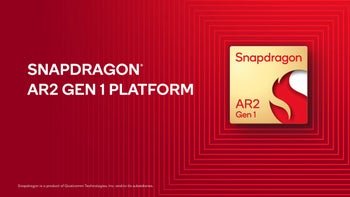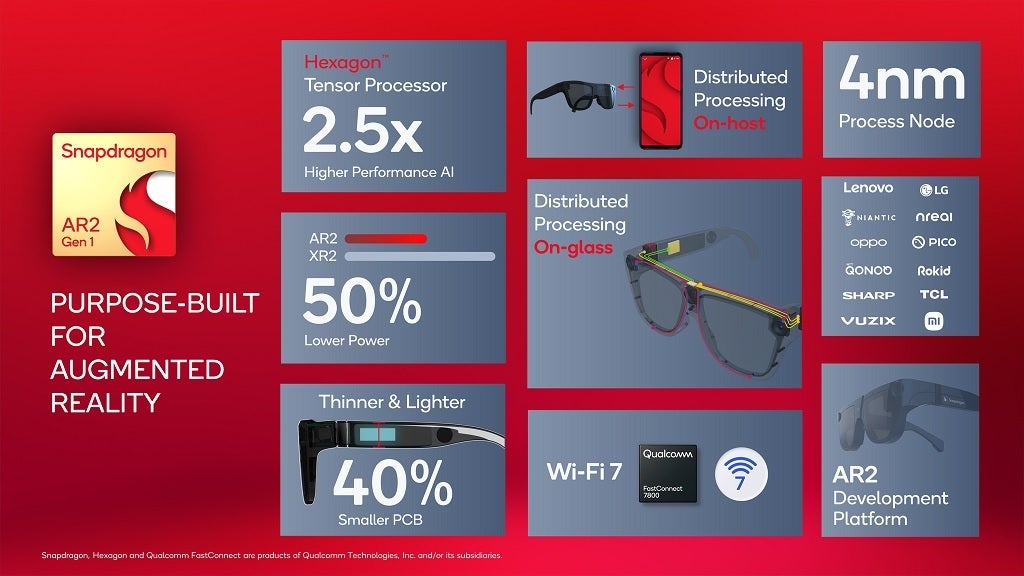Qualcomm unveils Snapdragon AR2 Gen 1 Platform for headsets and smart glasses

Yesterday Qualcomm kicked off the 2022 Snapdragon Summit by introducing the next generation of its top-of-the-line Application Processor (AP), the Snapdragon 8 Gen 2. This chip will be inside devices available to consumers by the end of this year. Today, the San Diego-based chip designer unveiled the Snapdragon AR2 Gen 1 Platform designed to deliver augmented reality (AR) for smart glasses and other head-worn gear.
The new chip is part of Qualcomm's Extended Reality (XR) offerings. Qualcomm says that the Snapdragon AR2 Gen 1 "delivers groundbreaking AR technology that will unlock a new generation of sleek, highly capable glasses. The Company built Snapdragon AR2 from the ground up to revolutionize the head worn glass form factor and usher in a new era of spatial computing experiences for the real-world/metaverse mix."
The Snapdragon AR2 Gen 1 delivers 2.5 times the AI performance using 50% less power
Augmented reality is a technology that places computer-generated images (CGI) on top of the user's real-world view of the world. A good example of this is the Live View AR feature available for Google Maps for those who are walking to a destination. The phone's rear camera provides the user with a real-time image of what is in front of him while CGI images of arrows will appear over the real-time image to help guide and navigate the user to his destination.

Qualcomm unveils its Snapdragon AR2 Gen 1 Mobile Platform for AR headsets
The main processor on the Snapdragon AR2 Gen 1 takes up less space on the printed circuit board while still improving AR performance by 2.5 times. The chip also uses 50% less power. As Qualcomm puts it, "This enables rich AR experiences on glasses that can be comfortably worn for extended periods of time and meet the demands of both consumers and enterprise use cases."
With the platform, data that is latency-sensitive such as video streaming, surgery, multi-player video games, and computerized stock trading, will be sent directly to the headset. Other, more complex data requirements, will be off-loaded to a Snapdragon-powered smartphone, PC, or another kind of compatible host device.
The AR processor is designed for headsets with multiple cameras and will, in fact, support up to nine concurrent cameras. The platform is made up of a multi-chip architecture which is important when you're dealing with the limited space available with smart glasses. There is an AR processor, an AR co-processor, and a connectivity platform.
The latency between AR glasses and a smartphone using the chip is less than 2 milliseconds
Hugo Swart, vice president of XR product management, Qualcomm Technologies, Inc. says, "We built Snapdragon AR2 to address the unique challenges of head-worn AR and provide industry-leading processing, AI, and connectivity that can fit inside a stylish form factor. With the technical and physical requirements for VR/MR and AR diverging, Snapdragon AR2 represents another metaverse-defining platform in our XR portfolio to help our OEM partners revolutionize AR glasses."
The AR co-processor will handle important tasks such as eye-tracking and can also use iris authentication not only to verify identity but also to render certain images only when the user is looking at a certain part of the display. This could save on power consumption.
The system also uses the FastConnect 7800 connectivity platform allowing it to utilize Wi-Fi 7. This will allow latency between AR glasses and the host device (including a smartphone, if that is the case) to be less than 2 milliseconds (ms).
The Snapdragon AR2 Gen 1 will be built on a 4nm process node (Qualcomm will not reveal which foundry is producing the chip) and Qualcomm is in "various stages of development" with manufacturers interested in the platform "including Lenovo, LG, Nreal, OPPO, Pico, QONOQ, Rokid, Sharp, TCL,Vuzix and Xiaomi.
Rubén Caballero, Corporate Vice President of Mixed Reality, Devices & Technology at Microsoft stated that "Microsoft worked closely with Qualcomm on the platform requirements for Snapdragon AR2 to help define the purpose-built, foundational technologies to unlock new possibilities in AR experiences. Snapdragon AR2 platform innovations will revolutionize head-worn AR devices that will transform immersive productivity and collaboration and we look forward to seeing the innovation that Qualcomm and its partners will bring to market."













Things that are NOT allowed: